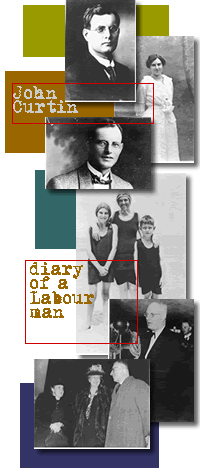


John Curtin was sworn in as Prime Minister on 7 October 1941 and was immediately beset with an escalating series of crises. The loss of HMAS Sydney in mid-November, the attack on the American fleet in Pearl Harbour and the loss of two British warships, Prince of Wales and Repulse, in early December 'placed Curtin at the head of a nation at war for its own survival.'
With the fall of Singapore imminent, Curtin broadcast his famous New Year’s message making it clear that Australia looked to America ‘free of any pangs as to our traditional links or kinship with the United Kingdom’.
During these difficult years, until victory appeared likely, Curtin and his government had to deal with the threat of invasion and the military conduct of the war as well as maintain national morale in a climate of austerity.
Against the backdrop of war, the Prime Minister had political battles to fight, including convincing his ALP colleagues to allow conscripted militia to serve outside Australian territory and winning the federal election of 1943. With victory in sight, his government's change of focus to post-war reconstruction brought its own particular problems as Curtin and his ministers tried to prepare Australia for a post-war world.1
Through difficult periods of separation, Curtin's family relationships remained strong. His wife Elsie spent several months a year in Canberra during his prime ministership and accompanied him to the United States and Canada in 1944. At Curtin’s wish she retained their home in Cottesloe as a family base, and when apart, they maintained close contact through nightly phone calls and frequent letters. Their daughter Elsie stayed with Curtin in the Lodge on several occasions, while her brother John served in the RAAF.2
With little time for leisure activities, Curtin still managed to maintain friendships and to follow in some measure his favourite sports of football, cricket and horse racing. However, unable to disassociate himself from the plight of others, he was weighed down by the momentous decisions he had to make, and this took its toll. Curtin was often ill and towards the end of 1944, after a demanding overseas trip, he suffered a heart attack and was hospitalised. He returned to work for only a few months and died on 5 July 1945.
The diary in this frenetic period can only capture Curtin’s activities in small part, but the sources used reflect his important status as Prime Minister of Australia. National newspapers, parliamentary digests, abstracts of speeches, minutes of caucus meetings and press conferences have replaced earlier accounts from the Westralian Worker. Entries based on the Digest of Decisions and Announcements and Important Speeches by the Prime Minister are numerous but may provide a skewed view of Curtin’s activities as it is unlikely that he had input into every one of the statements attributed to him.
Some days nothing is recorded of his movements, no interviews were given and no statements made. This is possibly due to censorship or these days may have been spent dealing with routine matters such as letter writing and processing diplomatic exchanges, duties which on occasion became so onerous they demanded his whole attention.
We invite you to explore the diary of Curtin's life as Prime Minister from 1941 to 1945.